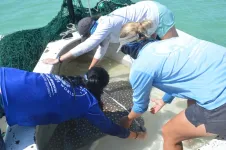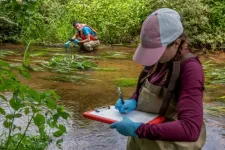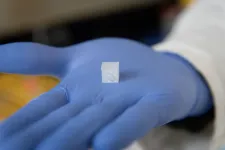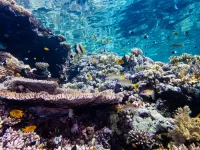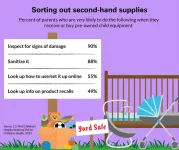(Press-News.org) Clam leases are designated underwater locations used to produce hard clams of all sizes from littlenecks to chowders. Clam production or aquaculture can be a risky business due in part to unwanted marine intruders. Among them, stealthy and highly mobile rays.
The Indian River Lagoon is one key location used for hard clam (Mercenaria mercenaria) aquaculture operations along Florida’s Atlantic coast. Clam fishermen have anecdotally reported seeing rays in clam leases and suspect that their interactions could result in damaged aquaculture gear and crushed clams. After all, some species of rays are equipped with mighty jaws and plate-like teeth that make them highly capable culprits.
Inspired by clammer reports, researchers from Florida Atlantic University’s Harbor Branch Oceanographic Institute and collaborators, used passive acoustic telemetry to gauge the interactions between two highly mobile animals, whitespotted eagle rays (Aetobatus narinari) and cownose rays (Rhinoptera spp.) in two clam lease sites and four other sites in Sebastian, including the Sebastian Inlet and the Saint Sebastian River mouth. Since visual observations can be challenging and unpredictable, this technology enabled researchers to monitor the tagged rays in the wild over two years.
“We wanted to understand how often and when rays visited these clam leases, how long they stayed there, and if it was seasonal or year-round,” said Matt Ajemian, Ph.D., senior author, an associate research professor and director of the Fisheries Ecology and Conservation Lab at FAU Harbor Branch. “We tagged them, set them on their way and logged 17,014 unique visits to the leases derived from 38 different rays.”
Findings from the study, published in PLOS ONE, provide both good news and bad news for clammers. Rays spent even more time in these clam lease sites than clammers reported or suspected, but it’s not necessarily where they prefer hanging out. For example, whitespotted eagle rays spent only 6.2 percent of their time near clam lease locations and cownose rays 13.2 percent.
Predicting when and for how long rays visit the clam leases also was complicated as it depended on the species, time of day, season, and even certain environmental conditions. Despite less frequent use when compared to other reference receiver locations, both species of rays exhibited longer visits at clam lease sites than some locations considered and were periodically observed within the clam lease regions for extended periods of time. The longest continuous duration spent at the northern and southern clam leases were 387.5 and 207.1 minutes, respectively. This shows that rays can remain within these areas for hours at a time, which increases the likelihood in which they are interacting with, and potentially foraging upon, the clam leases.
“Since 84 percent of all visits were from whitespotted eagle rays and their visits were significantly longer at night, this information suggests that observed interactions with the clam leases are potentially underestimated, given most clamming operations occur during daytime,” said Brianna Cahill, corresponding author, an FAU Harbor Branch marine science and oceanography graduate, and a research technician at Stony Brook University. “Results from our study justify the need to continue monitoring mobile predators in the region, including more studies to assess their behaviors such as foraging at the clam lease sites.”
Cownose rays and whitespotted eagle rays have different migratory patterns, but in both cases their tendency to be mobile may limit their impacts on clammers.
“Additional good news for clammers is that rays did not use the clam lease sites year-round, and their visits varied seasonally, with substantially fewer detections and visits during the summer months,” said Ajemian. “This suggests that clammers need only deploy anti-predator protections against rays, if needed, for a portion of the year.”
Findings from the study also highlight the need to understand if clam leases are situated within rays’ natural foraging habitats and if rays are actively interacting with the clam leases or if they may be attracted to other organisms nearby.
“It’s possible that rays may be feeding on other organisms that are attracted to the clams in the clam lease sites, as bivalve aquaculture farms have been known to change community structure and attract a wide variety of predatory snails, that may be an alternative attractant for cownose and whitespotted eagle rays given their diets,” said Cahill.
Study co-authors represent the University of Massachusetts Dartmouth; Bonefish and Tarpon Trust; Smithsonian Environmental Research Center; and Dalhousie University in Canada.
- FAU -
About Harbor Branch Oceanographic Institute:
Founded in 1971, Harbor Branch Oceanographic Institute at Florida Atlantic University is a research community of marine scientists, engineers, educators and other professionals focused on Ocean Science for a Better World. The institute drives innovation in ocean engineering, at-sea operations, drug discovery and biotechnology from the oceans, coastal ecology and conservation, marine mammal research and conservation, aquaculture, ocean observing systems and marine education. For more information, visit www.fau.edu/hboi.
About Florida Atlantic University:
Florida Atlantic University, established in 1961, officially opened its doors in 1964 as the fifth public university in Florida. Today, the University serves more than 30,000 undergraduate and graduate students across six campuses located along the southeast Florida coast. In recent years, the University has doubled its research expenditures and outpaced its peers in student achievement rates. Through the coexistence of access and excellence, FAU embodies an innovative model where traditional achievement gaps vanish. FAU is designated a Hispanic-serving institution, ranked as a top public university by U.S. News & World Report and a High Research Activity institution by the Carnegie Foundation for the Advancement of Teaching. For more information, visit www.fau.edu.
END
CAPE COD, MASSACHUSETTS – Earlier this year, the US Environmental Protection Agency proposed maximum allowable levels in drinking water for six PFAS (per- and polyfluoroalkyl substances) – so-called forever chemicals. But the draft standards do not account for half of the PFAS at contaminated sites across the country.
The findings are from a team led by the Harvard John A. Paulson School of Engineering and Applied Sciences (SEAS) and are published in the journal Environmental Science & Technology.
PFAS are present in fire retardant foams ...
Embargoed for release: Monday, May 15, 2023, 8:00 AM ET
Boston, MA – People who live in communities with higher proportions of Black and Hispanic/Latino residents are more likely to be exposed to harmful levels of per- and polyfluoroalkyl substances (PFAS) in their water supplies than people living in other communities, according to a new study led by researchers from Harvard T.H. Chan School of Public Health. The researchers link this finding to the disproportionate siting of sources of PFAS pollution—such ...
WINSTON-SALEM, NC – MAY 15, 2023 – The Wake Forest Institute for Regenerative Medicine (WFIRM) will make history this month when the first bioprinted solid tissue constructs soar to the International Space Station (ISS) on board the next all private astronaut mission by commercial space leader Axiom Space.
The Axiom Mission 2 (Ax-2) launch by Houston-based Axiom Space is launching from Florida’s Kennedy Space Center. The crew will conduct extensive scientific research experiments including WFIRM’s vascularized tissue research – which won first place in the NASA Vascular Tissue Challenge in 2021.
Liver ...
While a visit to the great outdoors is a common prescription for reducing screen use, a pioneering new study finds that time outdoors doesn’t always reduce smartphone screentime.
The new research, which tracked smartphone activity of 700 study participants for two years, reveals that participants’ smartphone activity actually increased during visits to city parks and other urban green spaces.
With smartphone use rising worldwide, the study clearly identifies a powerful way to reduce screen time: participants who visited nature reserves or forests saw significant declines in screentime over the first three hours, ...
BALTIMORE, Md. (May 15, 2023) – More than 100 genes linked to the risk of schizophrenia seem to cause illness because of their role in the placenta rather than in the developing brain, according to a new study led by the Lieber Institute for Brain Development.
Scientists had generally assumed for over a century that genes for schizophrenia risk were principally, if not exclusively, about the brain. But the latest research, just published in Nature Communications, found that the placenta plays a much more significant role in developing illness than previously known.
“The secret of the genetics of schizophrenia has been hiding in plain ...
Statement Highlights:
In a review of the latest research, few stroke studies addressed racist policies, such as residential segregation, or social determinants of health, such as neighborhood deprivation, walkability or security; food availability; economic stability; education quality; or employment and health insurance, all of which play a role in stroke incidence, care and outcomes.
The statement summarizes research on interventions to address racial and ethnic disparities in stroke care and outcomes.
Additional research is needed to determine ...
The light pollution caused by coastal cities can trick coral reefs into spawning outside of the optimum times when they would normally reproduce, a new study has found.
Coral broadcast spawning events – in which lunar cycles trigger the release of eggs on certain nights of the year – are critical to the maintenance and recovery of reefs following mass bleaching and other similar events.
However, using a combination of light pollution data and spawning observations, researchers were able to show for the first time that ...
LA JOLLA, CALIF. – May 15, 2023 – Researchers from Sanford Burnham Prebys and the Chinese University of Hong Kong have developed a computational approach to predict whether a person with type 2 diabetes will develop kidney disease, a frequent and dangerous complication of diabetes. Their results, published in Nature Communications, could help doctors prevent or better manage kidney disease in people with type 2 diabetes.
“This study provides a glimpse into the powerful future of predictive diagnostics,” says co-senior author Kevin Yip, Ph.D., a professor and director of Bioinformatics ...
Cribs, strollers and other infant and child equipment can be expensive and most families in a new national poll agree that it’s wasteful to buy these items new when they’re needed for such a short time.
But while half of parents say they have used pre-owned equipment for babies and young children, two in three acknowledge that it’s difficult to always know whether it’s safe for their child, according to the University of Michigan Health C.S. Mott Children’s Hospital National Poll on Children’s Health.
“Used child essentials ...
Managing cardiovascular disease (CVD) risk factors may play a role in preserving physical function during the aging process, according to new research published today by The Journals of Gerontology, Series A: Biological Sciences and Medical Sciences.
“Approximately 10% of older adults have muscle weakness and diminished physical function that leads to adverse health outcomes and physical disability,” said lead author Dr. Shivani Sahni. “Since loss of physical function contributes to reduced mobility, disability, institutionalization, and mortality, management of CVD risk factors can help preserve physical function with age,” ...
